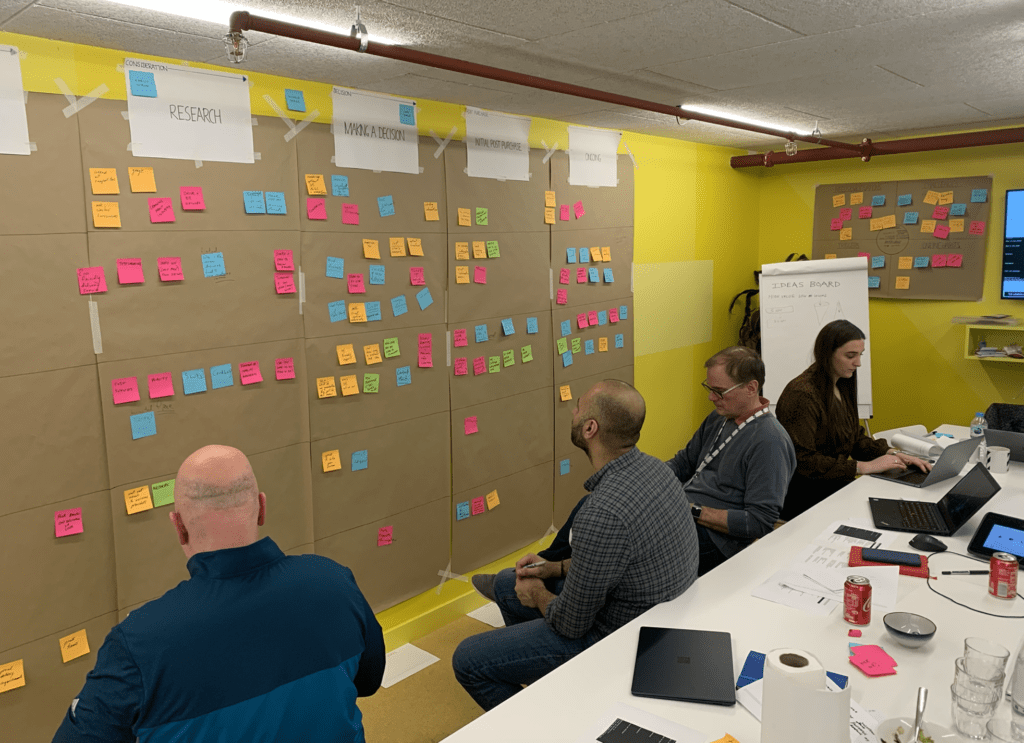How do we run a UX workshop?

A UX workshop is an intensive collaborative session between the agency and the client, used to solve problems and enable progress on any particular challenges during a project timeline. The workshop typically involves a set of hands-on tasks and idea generation within a concentrated time.
The key reasons why at ClarityDX we run the workshops:
- To consolidate existing knowledge from clients or stakeholders
- To understand the business, design & technical requirements
- To understand user requirements
- To build a general consensus and alignment amongst stakeholders
The prevailing theme in all of the above however, would be to have the user/s in mind at all times. Given this, the UX workshop is a great opportunity to immerse ourselves in a user’s perspective and attempt to eliminate any bias – though this can be a great challenge and often requires constant monitoring.
How can you use a UX workshop as part of a discovery & definition phase?
The workshop should occur at the discovery and definition stage of a project. That is because at this stage the agency will typically be seeking as much information as possible about the client and their customers or users. The outcomes of the workshop will dictate the nature of other critical elements of discovery and definition phase such as determining user flows and wireframes for a website.
The UX workshop is particularly effective where the client stakeholder’s views don’t typically align with one another. It can be wrong (and potentially disastrous in the latter stages of a project) to assume that because they are part of the same company, they must have similar drivers and expectations. The UX workshop acts as a forum to collaborate, discuss and harmonise these ideas, whilst making sure the project remains focused on the user or customer.
How to plan a UX workshop
The job of planning and even facilitating workshops usually falls upon the UX/design lead who designs the flow of the workshop and plans collaborative exercises that will lead attendees toward a common goal.
For our most recent workshop we conducted there were four contributors from ClarityDX team. James, our Senior Digital Account Director and Nicola, our Head of UX & Design facilitated, whilst myself and Digital Designer Fenella provided assistance.
The planning was broken down into 3 stages:
- Determining tasks: This isn’t as easy as it first seems. There are a number of tasks that could be implemented during a user workshop and determining them is usually defined by the information that has already been shared by the client. There are however a key set of tasks that are applicable for most projects that seems to return significant insight, these are ‘Gap Analysis’ and ‘User Journey Maps’.
- Preparing collateral: Upon determining the appropriate tasks, the collateral needs to be prepared in order for the stakeholders to get involved. Typically, this requires swathes of paper and hundreds of post-it notes and a myriad of other stationary is required. The preparation of these materials is paramount to the smooth running of the day as we want to make sure everyone is sufficiently prepared to submit what could be vital information.
- Practising: This enlists a lot more confidence in the facilitators and assistants, giving us an opportunity to tweak where necessary. In prep for our most recent workshop, we took part in the activities using a proto-persona we had made ourselves.

Which stakeholders should be involved in a UX workshop?
At a bare minimum, you’d want to invite everyone who will be working on the project (though this is sometimes out of the question with larger clients!). It’s also wise to include any key decision makers and anyone who can provide insights into the company and its customers – often this means not just marketers, but colleagues from sales, business development, product and so on.
It’s especially useful if you can invite those who will fly the flag for the end user. Staff in sales/customer facing roles are perfectly placed to represent the end users point-of-view if user research has not yet been undertaken, and will be able to offer valuable insights into the users’ motivations, needs, problems, and pain-points.
Where possible, inviting actual users to your workshop is highly recommended and will help to demystify any incorrect preconceptions or biases that stakeholders may have.
A well run UX workshop will leave you with the following:
The format and content of a UX workshop will change depending on the product, desired outcome, and deliverables but in conducting one you will have greater insight into the company’s users. The workshop should help you to:
- Clearly define who the audience is
- Gain a better understanding of what the website needs to deliver to its users
- Provide a starting point from which wireframes can be developed for key pages of the site
At ClarityDX were are continuing to be flexible in our approach to UX workshopping for our clients but our underlying motives have been (and will continue to be) the focus on user centricity.

Meet the team: Fenella

Optimise your WordPress site with Cloudflare
Let's Talk
Do you have a web design and build project coming up that you would like to talk about?